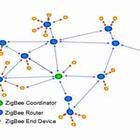 WSNs
WSNsRecent advances in wireless communications and electronics have enabled the development of low cost, low power, multifunctional sensor nodes that are small in size and communicate untethered in short distances. These tiny sensor nodes, which consist of sensing, data processing, and communicating components, leverage the idea of sensor networks. Sensor networks represent a significant improvement over traditional sensors.
A sensor network is composed of a large number of sensor nodes that are densely deployed either inside the phenomenon or very close to it. The position of sensor nodes need not be engineered or predetermined. This allows random deployment in inaccessible terrains or disaster relief operations. On the other hand,this also means that sensor network protocols and algorithms must possess self-organizing capabilities. Another unique feature of sensor networks is the cooperative effort of sensor nodes. Sensor nodes are fitted with an onboard processor. Instead of sending the raw data to the nodes responsible for the fusion, they use their processing abilities to locally carry out simple computations and transmit only the required and partially processed data.
The above described features ensure a wide range of applications for sensor networks. Some of the application areas are health, military, and home. In military, for example, the rapid deployment, self-organization, and fault tolerance characteristics of sensor networks make them a very promising sensing technique for military command, control, communications, computing, intelligence, surveillance, reconnaissance, and targeting systems. In health, sensor nodes can also be deployed to monitor patients and assist disabled patients. Some other commercial applications include managing inventory, monitoring product quality, and monitoring disaster areas.
Realization of these and other sensor network applications require wireless ad hoc networking techniques. Although many protocols and algorithms have been proposed for traditional wireless ad hoc networks, they are not well suited to the unique features and application requirements of sensor networks. To illustrate this point, the differences between sensor networks and ad hoc networks are:
* The number of sensor nodes in a sensor network can be several orders of magnitude higher than the nodes in an ad hoc network.
* Sensor nodes are densely deployed.
* Sensor nodes are prone to failures.
* The topology of a sensor network changes very frequently.
* Sensor nodes mainly use a broadcast communication paradigm, whereas most ad hoc networks are based on point-to-point com munications.
* Sensor nodes are limited in power, computational capacities, and memory.
* Sensor nodes may not have global identification(ID) because of the large amount of overhead and large number of sensors.

